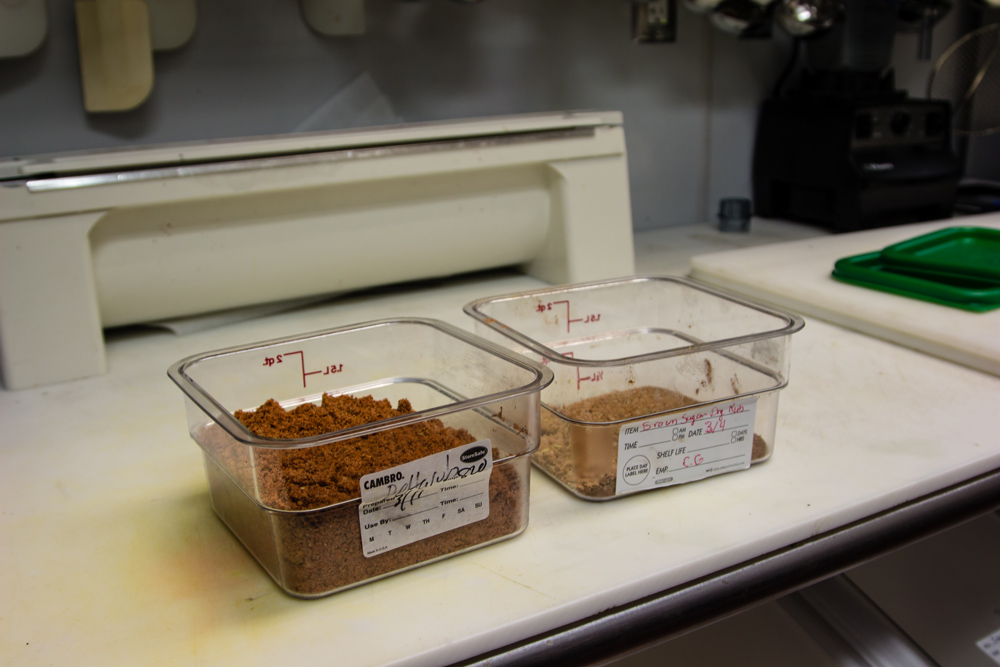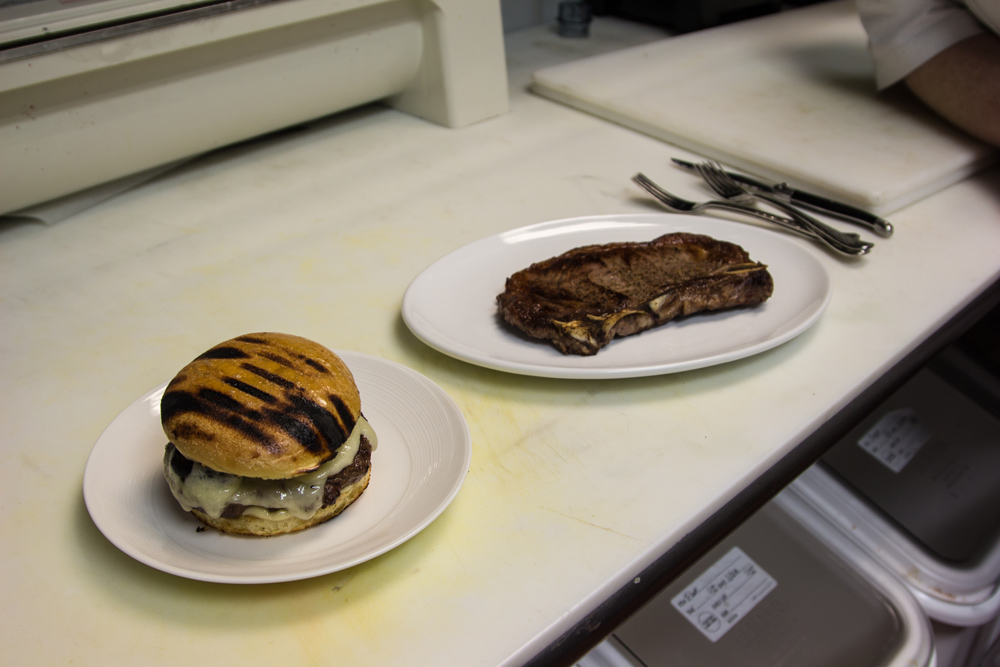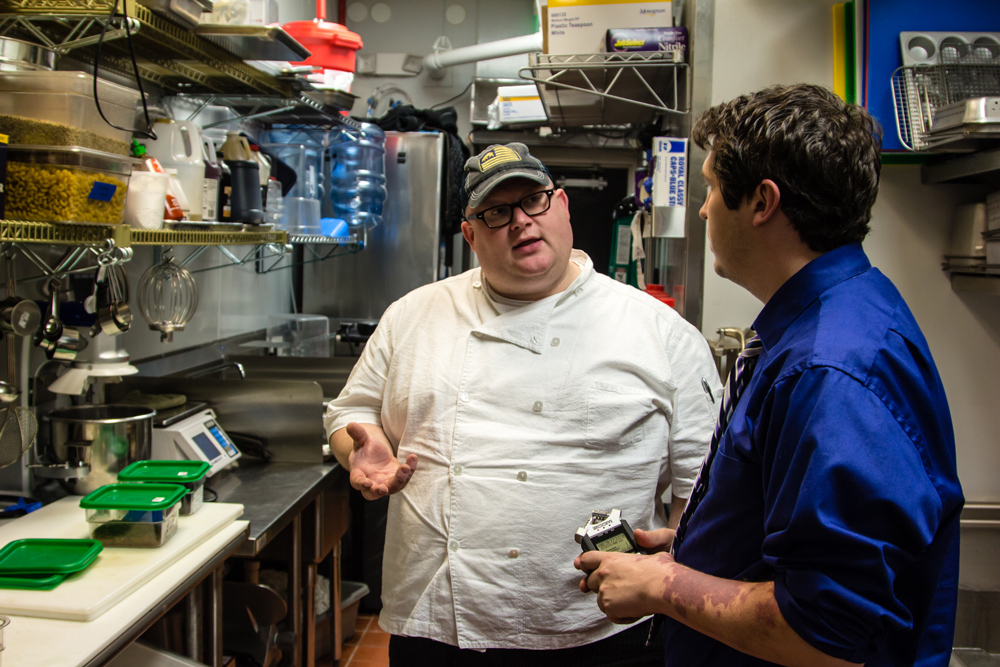Update: Kent Graham is no longer with Block & Grinder.
This is part 2 of our interview with Jed Kampe and Kent Graham of Block & Grinder. Jed is the owner and general manager, and formerly owned the New York Butcher Shop on Selwyn Ave. Kent is the executive chef. You can check out part 1 of the interview here. We left off the last interview as Jed was telling us of his plans to create this new butcher shop/restaurant hybrid.
_______________________________________________________________________________________________________
Jed Kampe: So this space was available [on Providence Road]. Panda [Express] left everything. Because they didn’t go out of business, they just walked out. Apparently in the Southeast they are going to go into the freestanding world. That may be a part of what made the the lease take so long. But we made use of the time. I somehow got a key. So we actually worked with our engineer on the original plans and had them all submitted and approved so as soon as that lease was signed, we were good. We maximized all that down time as best we could.
Kent Graham: I mean, building this kitchen was not an easy feat. We were counting inches to make sure that certain pieces of equipment would fit in certain spaces. Because you can’t reposition a huge walk-in.
Charlotte Burger Blog: Is it ideal to have the grinder in the freezer, or is it just a space thing?
Kent Graham: No, it’s ideal. Because you want to keep that metal as cold as possible. As it grinds it’s going to create heat. The heat will continue to cook the burger. By keeping it in the refrigerator we’re maintaining a low temperature on the grind. Basically, fat, like water, like anything, you have to make an emulsion. It will separate, it will break. By keeping it cool we’re helping to maintain the fat in a soluble state so it does maintain a solid emulsion.
Jed Kampe: The other thing about ground beef, the reason it’s always the one you hear about when E. coli or something comes out, is because every piece of that whole strand is exposed to the air. That’s why there are all the laws about medium-rare or rare and not so much for steak.
Charlotte Burger Blog: So how often will you be grinding the meat?
Jed Kampe: You can compare it to Krispy Kreme with the [sign] “Hot Donuts Now,” you may actually see the grind being ground, the burger being pattied, put on the grill, put on a plate, and put on your table. The whole process. We won’t know until we open, but I’ll say we’ll do at least two grinds a day, maybe three, depending on how much we grind at one time.
Kent Graham: It’s also a safety issue. We want to grind as we need.
Jed: We want to stick to the idea that if you come in and have a burger that day, that beef was ground that day.
Charlotte Burger Blog: I read about the blind taste test in choosing your meat. Can you tell us more about that?
Jed: I used a few different purveyors, Kent’s obviously very educated in purveyors as well, and we were getting a whole bunch of samples. Some of them stood out. Some of them weren’t great, but they were fine. Once we got to the point where we wanted to go all-natural, we set it up where we picked the ones that we thought we would be choosing from. Then Kent, myself, and my parents, who are part of the investment group, we all sat with our Thanksgiving clothes on and tried them. Our sous chef cooked everything exactly the same and we didn’t do any seasoning, we wanted to just taste the meat. And we graded it on, what, Look, Taste…
Kent: Mouth Feel, Cut…
Jed: Yeah, how it chewed, everything. One stood out as the clear dead last, compared to the other ones. It wasn’t bad, if you go to most places that would probably be a hell of a steak. For me there were two that were close, and there was one I was rooting for and it was the one we ended up going with. You may want to explain how you picked the beef.
Kent: Yeah, we did our first round of testing and then we did all the strips and all the ribeyes. We’re at 8 steaks already. Then we went back and cooked them the way that we would prepare them in-house, which is totally different than the way we tested. We wanted to taste, number one, the meat by itself, but then under our design. Everything stepped up a notch the way we did it. It’s not proprietary, but we still keep under wraps the way we cook a steak. Let’s just say that everything is cooked in cast iron at a high heat. The second time we did it even more things stood out. We were able to taste more in the flavors, we were able taste more of the earthiness of the grass and the grain by which it was finished with. We were able to really feel the meat.
The process I went by in picking these was, number one, I wanted to find an all natural program. Then, in looking at an all natural program, I wanted to find a program that was genotype and not phenotype. Genotype program looks at the genetic lineage of the animal, proving that it is 100% of that particular breed. A phenotype program looks at the animal and only has a 51% chance or better of a black hide, therefore it is a black Angus. The way I look at it, while a phenotype program is good, I wanted our meat to be gene specific. Because that way it maintains continuity of the size and the weight of the animal throughout its life. It’s a little more predictable about what’s going to happen.
Jed: It also gets away from the term “Angus,” which, unfortunately now has become so saturated. When McDonald’s has an “Angus” burger, it raises the question—what is Angus? I guess it’s the best eating cow you can get, other than a Kobe, but—
Kent: Ours actually isn’t a black Angus, it’s a red Angus.
Jed: We’re just going to let the meat speak for itself. We found what we think is the best stuff, it’s got a great marbling, great flavor, great tenderness.
Kent: The company that we decided to go with for our program is a small company. They use about five slaughter facilities, but they also have a bunch of different brands that they work which are almost as a cooperative. Each one of those brands has their own slaughter facility. So there is one USDA inspector that is inspecting all the beef that is coming down this assembly line. That’s how it’s all regimented.
They even go out to the point of measuring the grass in the fields to make sure that the grass is a certain height so that the cow does not get over stressed by having to dip its head too low. There are no mechanized equipment allowed in the pastures. They have to be herded by horseback without dogs to minimize the stress of the animal.
Charlotte Burger Blog: That’s amazing.
Kent: The standard is, what, 30 days in a feed lot for the average animal? We’re looking two to three times that for these. It’s a wonderful process. These animals come to you stress free. The difference is easy to taste. Take something as simple as a hanger, which has to be heavily butchered to get it just right. We can actually do less butchering on a hanger, because the animal is just not so tough. It doesn’t have those sinews, the meat never seized. We have a really great tasting meat.
(At this point Kent allowed us to taste some of the dry rubs he uses in several dishes, including ribs and pork butt.)
The way we do things here is so much about trying to use great flavors that accentuate. Our flavors are not designed to be overpowering. We want something that is big and bold and it’s a great flavor, but it’s a great flavor that brings something more to the table.
When talking about where these animals are from, and especially the beef, one of the things I look at is well, where are they from exactly? What is the type of stuff that grows in that area? When and where in the year are they slaughtered? That lets me knows what was growing on the ground, that way I can accentuate it by saying, if it’s from Montana, there’s probably some sage, maybe a little bit of rosemary, that means there’s probably a hint of that in the meat. We can probably accentuate the meat’s taste by applying these essences to the cooking process.
Charlotte Burger Blog: I don’t know if we ever considered how much thought goes into this process.
Kent: Well, we’re trying to do things old-school and we’re trying to have fun. When you come here, you’re coming to my home. You’re not a client, you’re not a patron, you’re not a regular, you’re a guest. You’re a guest in our house. Sit at our table, you see our kitchen from the dining room, enjoy yourself and let us take care of you.
Jed: That’s why I insist on not having any televisions. I might sneak one on the patio, but Kent had a great point. Our menu is very expansive and is very unique, but when you boil it down it’s basic. All that liquid nitrogen and stuff that’s going on in some of these places, we’re not going to have here. It’s a basic approach, but we’re still having fun with it. The food on its own, if done the right way—and Kent knows how to do it—you can bring flavor out of just two or three ingredients. It’s not easy, but they don’t consist of a thousand ingredients either.
Kent: Using a minimal amount of ingredients is either a very long rope or a very short rope—it depends on how you want to hang yourself. I would rather hang myself with my principles and my ethics than taking a piece of steak, butterflying it, and cooking it well done.
You know, my philosophy when it comes to meat is this: if you want a well-done steak, ask for it medium. Try it. If you don’t like it, if you can’t get past the texture, not a problem. Send it back to me, I’ll cook it up. But at least try it.
To get back to something Jed touched on a minute ago, we have no TVs here. The reason for it is simple. You’re here to eat with somebody. Talk to them. Have a conversation. Talk to the table next to you. I can’t think of how many times I’ve been in New York where you’re elbow to elbow and you’re at different tables, but I’ve had some of the best conversations with perfect strangers. We part ways and never see each other again, but it was a great experience.
If a TVs on, guess what you’re going to be doing. Looking up at the TV. Don’t look at the TV, look at the person across from you. Talk. Have a good drink. Sit. Relax. Just enjoy.
Charlotte Burger Blog: We agree completely. That’s why we started the Charlotte Burger Blog, to capture those conversations that we were having when we were out.
Now, tell us about the iPads your servers use and how that helps the ordering process.
Jed: Kent is the one that brought this idea in, and he’s right, it’s where it’s all going to go. Pretty soon it’ll be at the table.
My biggest pet peeve, it drives me absolutely crazy, is when you go out to eat and they don’t write down the order. Ninety-nine percent of the time they get it right, but 100% of the time I think about it the entire time until my food comes. And it doesn’t impress me.
The cool thing about it is that it’s more efficient. You guys come and sit down, I come take your order, and you order a couple of beers and an appetizer right off the bat. I hit that and the ticket is already printed at the bar, they’re pouring your beer. The ticket’s already printed in the kitchen and they’ve started your appetizer. I haven’t even walked away from the table. I don’t have to go to another terminal and punch it in, maybe screw that up. We can also put tasting notes on it, pairing notes with it.
I think it’s a neat little feather in our cap. We debated how much we wanted to play it up. I mean, you may come back in two weeks and we’re writing everything down.
___________________________________________________________________________________________________
 We talked a lot more with those guys after that. And Kent cooked us a shitake and gruyere burger and a steak. It’s no surprise that they were both amazing. We would like to thank them both for the time they spent talking with us and showing us how they run things there. We walked away very impressed.
We talked a lot more with those guys after that. And Kent cooked us a shitake and gruyere burger and a steak. It’s no surprise that they were both amazing. We would like to thank them both for the time they spent talking with us and showing us how they run things there. We walked away very impressed.
The day after the interview we stopped by for their “Meat and Greet” (get it?!) and did a review, which we’ll publish later this month. But you can stop by now and get some of the most innovative food in the Charlotte area. We feel assured in saying this: you will not be disappointed.

